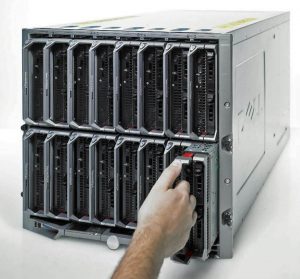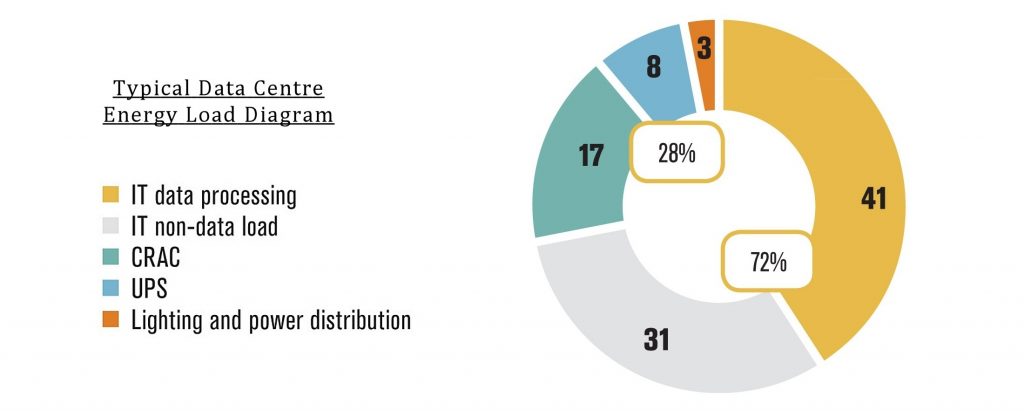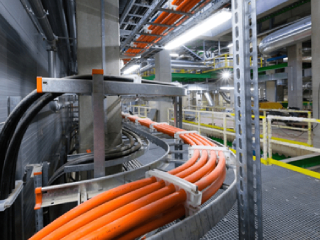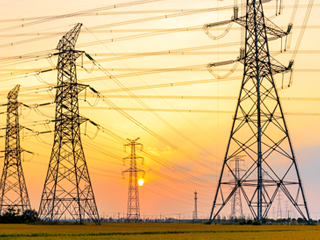Managing the operations of a data center is taxing. Besides maintaining uptime of your IT infrastructure, considering energy costs is vital. Every data center manager or designer will meet this critical concern. Datacenter energy reduction is directly proportional to reducing overhead costs. In some locations, it is even becoming impossible to obtain more power. Singapore has a moratorium on new data center construction while it addresses power and water challenges. Until renewable energy sources and low PUE numbers are achieved no new data centers can be constructed in the city-state.
The lifeline of data centers is energy. IT infrastructure has specific power demands. Datacenter growth is meaning additional high-density racks are being deployed. High-density racks are energy haulers. But they are also a solid investment to address growing demands. Striking a balance between achieving high-density environments and energy efficiency is a constant challenge for data center engineers.
This is why energy reduction efforts are part and parcel of data center management. Energy reduction comes in many facets and forms. As essential as IT hardware choices can bring substantial reduction to energy exhaust. The advancement in computer efficiency has made a big stride to ease the operational overhead of data centers.
Data Center Energy Reduction Steps
Energy reduction has no end-all strategy to provide a foolproof outcome. But there are proper steps to make it happen. Here are a few:
- Make It A Point To Turn Off Inactive Equipment
Utilization activity is a critical process for data center hardware. But often, IT equipment is not maximized for its capacity. There will be servers standing idle with only around 10% utilized. Storage devices have a relatively bigger capacity left.
Despite not utilizing these devices, they still extract power at total usage. A standard x86 server will use 40% of power even if it is already idle. While it is always imperative to use the full capacity of equipment, simply turning them off will gain significant energy reduction.
IT inventory is necessary to identify underutilized devices. Upon determining these devices, turning them off will be easy. Another course of action is to look for bloatware and delete it. Bloatware is software that uses significant CPU cycles.
- Server Aggregation
Multiple systems host different applications. There is a dedicated server and storage for this to run. This is done to manage applications separately. The outcome, however, is it uses up full power at peak load. Unfortunately, there is no assurance that these applications run in total capacity.
A shared platform can host the aggregation of servers and storage. The good thing is a shared platform can provide demarcation of individual applications and operating systems. A shared platform is commonly referred to as a process of virtualization. By virtualization, a separate application, despite segregated, can share hardware with other applications. By doing so, the hardware is utilized at full capacity. Negating the use of additional hardware reduces power consumption.
- Maximizing The Use Of Blade Servers

Photo Credit: squarespace-cdn.com/
Blade servers help consolidate servers in a data center. It can consolidate data centers themselves. Blade servers are especially beneficial because it uses a standard power supply in the same blade chassis. They are highly efficient in maximizing processing output given specific energy input. Providing high-density computing despite sharing networks and powers is a function that blade servers can significantly optimize.
Using blade servers can perform the same computing function at a reduced energy of up to 40%. This quantifier enables data centers to save up on costs despite many servers running.
- Storage Consolidation
Consolidating storage is another way to trim energy use. When storage volume increases, it directly needs more energy input. There are two ways for efficient energy reduction involving storage.
- Tiered Storage
It is vital to direct the drive usage in data operations. Using high-speed drives for more pertinent computing data is a must. Low-rate drives are best for applications that do not need immediate processes. It is crucial to note that operating speed should be slow despite having a larger disk drive. This is one way of decreasing energy usage.
- Consolidated Storage
The best option to consolidate storage is to use large disk drives. With larger storage capacity, utilization is flexible but warrant full usage. It improves utilization, but it can also cut down energy consumption.
- Make Use Of Power Management CPU Function
As the central processing unit (CPU), the device is the focal of power use. As such, energy consumption is relatively dependent on the CPU’s runtime. Computer technology nowadays has better chip components to counter the high energy use. Chipsets with energy-efficient features are a dime a dozen now. Quad-core technologies are a mainstream computer consideration for many users also.
Recent CPU trends offer power-management capacity. The feature enables multiple performance levels that can be switched as necessary. By changing voltage and frequency, energy use is also minimized. This is known as adaptive power management. It offers a sound compromise of energy reduction while enabling a standard processing function.
- Choosing IT With High-Efficiency Power Supplies
A power supply unit (PSU) is another component that increases power use at peak loads. An internal power supply determines the server to run. PSU also acts like an alternating current (AC) converter to direct current (DC). Such is the crucial function of PSU that requires significant power input.
Servers are one component that is endeavored to recalibrate efficiency. There are power supply certifications that merit IT efficiency. Based on this, one can determine the best IT for energy reduction. One thing to note is IT with highly efficient power supplies are hefty investments. While energy savings have concrete evidence, it is still best to check your data center operating demands. The right fit would be the most efficient.
- Power Distribution Strategy

Photo Credit: cleantechservices.ca
Power voltage from 100V to 240V is a norm in IT operations. It follows that using a high voltage results in better efficiency. While this is true, this is not always the case. As basic as utilizing the correct power cord can gain better efficiency traction with a lower cost.
Beyond the incremental benefit of input power selection, the better course of action is to leverage power distribution in a data center. Using an Uninterrupted power supply (UPS), for example, you can operate at 480V. A power distribution unit can decrease voltage up to 120V. Again, this is where highly efficient IT can reap the most advantage. But power distribution enables a better power chain that leads to efficiency gains. A simple voltage transformation will save up a higher cost in return.
- Recalibrate Cooling Practices
One extensive user of energy is cooling systems. And most of them are not exactly doing the job for a data center. Cooling units are not placed strategically. HVAC systems operate beyond standard conditions.
There are basic practices one can adjust to ensure better cooling turnout.
-
- Using hot and cold aisle arrangements to make sure cold air intake is properly navigated and hot air exhaust.
- Blanking panels to negate air mixing
- Cable holes should be sealed to negate bypass airflow
- Strategically placing cooling units to enclosures to maximize the cooling result
- Adopt A Regular Data Center Energy Audit

Photo Credit: www.domtech.com
A clear vision of a data center’s energy output is equivalent to reducing operational failure and costs. An audit can clear out vague accounts of power budget and IT equipment efficiency.
Datacenter efficiency follows this computation to account for IT components.
-
- IT Efficiency: Total IT output / Total Power Input To IT equipment
- Site Infrastructure Efficiency: Total Power Input To IT equipment / Total Power Consumed By The Data Center
- IT Output: True Output Of Data Center From An IT Perspective (this may refer to the number of applications relayed or web pages transmitted)
Specifically, site infrastructure efficiency can be based on the power usage effectiveness (PUE) ratio.
Optimizing Data Center Energy Reduction Actions
While energy reduction activities range from the most basic to technologically dependent, prioritizing efficient results is critical. In the context of a data center audit, simply logging the data will not cut it. There are DCIM solutions that can help optimize audit activities. These solutions can also comprehensively optimize the data center operations as a whole
ACKPro Server – Live PUE Calculations
The AKCPro Server is a DCIM solution that streamlines any data center audit process. Its capable monitoring system has advanced features on several data center monitoring outputs such as:
-
- Cabinet thermal mapping
- Drill down mapping
- Graphing
- VPN connections to remote sites
The most relevant feature it can aid data center managers for energy reduction is its live PUE calculations.
Having a handy tool to collect primary data on energy efficiency can help provide sound next steps in the data center operations. Aside from the PUE calculations, the AKCP ecosystem of products provides a complete data collection. These are thermal map sensors and power meters. They can give a comprehensive analysis that benefits any efforts on power cost reduction and ultimately PUE improvement.
Moving Forward
As you move towards improving data center operations, energy efficiency will always be an operational management consideration. Yes, it is essential to use the basic steps for energy reduction. But it is equally imperative to invest in a holistic and comprehensive data center monitoring approach for accurate results.
The priority is to increase energy efficiency without compromising IT runtime. As there will always be power demands, a simple step and a sound DCIM solution can help a long way.
Reference Links:
https://www.buildings.com/articles/34624/10-ways-save-energy-your-data-center
https://www.coolsimsoftware.com/Webinar-Archives/Data-Center-Energy-Reduction/Simulating-Data-Center-Energy-Linking-CFD-and-Cooling-Plant-Modeling
https://www.deltapowersolutions.com/en/mcis/white-paper-datacenter-efficiency-and-pue-measurement.php
https://www.buildings.com/articles/34624/10-ways-save-energy-your-data-center






